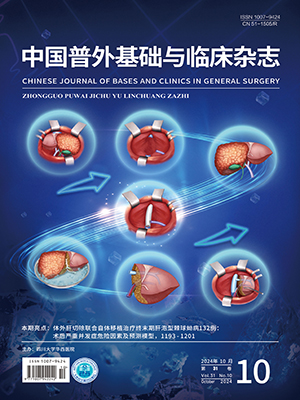| 1. |
王利新, 符伟国. 主动脉夹层治疗的现况. 中国血管外科杂志: 电子版, 2016, 8(1): 1-5.
|
| 2. |
中华医学会外科学分会血管外科学组. 主动脉夹层腔内治疗指南. 中国实用外科杂志, 2008, 28(11): 909-912.
|
| 3. |
中国医师协会心血管外科分会大血管外科专业委员会. 主动脉夹层诊断与治疗规范中国专家共识. 中华胸心血管外科杂志, 2017, 33(11): 641-654.
|
| 4. |
Erbel R, Aboyans V, Boileau C, et al. 2014 ESC Guidelines on the diagnosis and treatment of aortic diseases: document covering acute and chronic aortic diseases of the thoracic and abdominal aorta of the adult. The Task Force for the Diagnosis and Treatment of Aortic Diseases of the European Society of Cardiology (ESC). Eur Heart J, 2014, 35(41): 2873-2926.
|
| 5. |
刘一人, 徐兆明, 齐一侠, 等. 腔内技术治疗 Kommerell 憩室的临床研究. 中国普外基础与临床杂志, 2019, 26(9): 1101-1105.
|
| 6. |
董智慧, 符伟国, 王玉琦, 等. 胸主动脉腔内修复术后支架源性新破口—从支架力学损伤角度的思考. 中国普外基础与临床杂志, 2011, 18(10): 1031-1038.
|
| 7. |
袁丁, 赵纪春, 康裕建, 等. 3D 打印技术辅助复杂主动脉夹层腔内治疗. 中国普外基础与临床杂志, 2015, 22(7): 852-854.
|
| 8. |
刘昭, 李旭冉, 张明, 等. 3D 打印结合支架束径技术预三开窗治疗 Stanford A 型主动脉夹层1例. 中国血管外科杂志: 电子版, 2019, 11(2): 142-144.
|
| 9. |
杨探, 廖斌, 兰永树, 等. 三分支覆膜支架行主动脉弓重建治疗 Stanford A 型主动脉夹层效果的临床随访. 中国胸心血管外科临床杂志, 2019, 26(9): 933-935.
|
| 10. |
Hsu CP, Huang CY, Wu FY. Relationship between the extent of aortic replacement and stent graft for acute DeBakey type Ⅰ aortic dissection and outcomes: results from a medical center in Taiwan. PLoS One, 2019, 14(1): e0210022.
|
| 11. |
Faure EM, El Batti S, Sutter W, et al. Stent-assisted balloon-induced intimal disruption and relamination of distal remaining aortic dissection after acute DeBakey type Ⅰ repair. J Thorac Cardiovasc Surg, 2019, 157(6): 2159-2165.
|
| 12. |
Merkle J, Sabashnikov A, Liebig L, et al. Factors predictive for early and late mortality after surgical repair for Stanford A acute aortic dissection. Perfusion, 2019, 34(5): 375-383.
|
| 13. |
Kim TH, Song SW, Heo W, et al. Complete thoracic aorta remodeling after endovascular aortic repair: a new therapeutic goal for chronic DeBakey Ⅲb aneurysms. Semin Thorac Cardiovasc Surg, 2019, 31(3): 444-450.
|
| 14. |
中国心胸血管麻醉学会心血管麻醉分会. Stanford A 型主动脉夹层外科手术麻醉中国专家临床路径管理共识 (2017). 麻醉安全与质控, 2018, 2(1): 1-6.
|
| 15. |
Merkle J, Sabashnikov A, Deppe AC, et al. Impact of different aortic entry tear sites on early outcomes and long-term survival in patients with Stanford A acute aortic dissection. Thorac Cardiovasc Surg, 2019, 67(5): 363-371.
|
| 16. |
Reed AB, Self P, Rosenberg M, et al. Pre-emptive thoracic endovascular aortic repair is unnecessary in extended type A (DeBakey type Ⅰ) aortic dissections. J Vasc Surg, 2019, 70(3): e68-e69.
|
| 17. |
常光其. Stanford A 型主动脉夹层腔内治疗后并发症的原因和预防. 中国血管外科杂志: 电子版, 2012, 4(4): 209-211.
|
| 18. |
刘正琴. A 型主动脉夹层术后常见神经系统并发症的系列研究. 山东: 山东大学, 2017.
|
| 19. |
宋先荣, 程兆云, 刘富荣, 等. Stanford A 型主动脉夹层术后谵妄的临床研究. 中华胸心血管外科杂志, 2016, 32(10): 607-611.
|
| 20. |
Kim TH, Song SW, Lee KH, et al. Outcomes of stentless thoracic endovascular aortic repair for chronic DeBakey Ⅲb aneurysms. Ann Thorac Surg, 2018, 106(5): 1308-1315.
|
| 21. |
尚玉强, 戴仕林, 吴伟, 等. 一站式杂交手术治疗急性 Stanford A 型主动脉夹层. 临床心血管病杂志, 2016, 32(8): 823-825.
|
| 22. |
国家心血管病专业质控中心专家委员会血管外科专家工作组. 胸主动脉腔内修复手术质量评价指标体系的中国专家共识. 中国循环杂志, 2018, 33(7): 627-630.
|
| 23. |
Tang GH, Malekan R, Yu CJ, et al. Surgery for acute type A aortic dissection in octogenarians is justified. J Thorac Cardiovasc Surg, 2013, 145(3 Suppl): S186-S190.
|
| 24. |
左健, 杨剑, 王少玮, 等. 封堵器治疗局限性升主动脉穿通性溃疡. 心肺血管病杂志, 2013, 32(6): 730-731.
|
| 25. |
王石雄, 高秉仁, 王炜, 等. 食管超声引导下经胸封堵治疗局限性主动脉夹层. 临床心血管病杂志, 2016, 32(6): 636-638.
|
| 26. |
张喆, 陈学明, 李晨宇, 等. 腔内治疗破口位于升主动脉的 Stanford A 型主动脉夹层. 中国普通外科杂志, 2015, 24(12): 1649-1653.
|
| 27. |
黄晨, 周敏, 刘长建, 等. Stanford A 型主动脉夹层的腔内支架治疗进展. 中国血管外科杂志: 电子版, 2016, 8(2): 155-159.
|
| 28. |
叶志东. 破口位于升主动脉以远的 Stanford A 型夹层动脉瘤腔内治疗策略//中国医师协会、中国医师协会中西医结合医师分会. 2014中国医师协会中西医结合医师大会论文摘要集. 2014: 136.
|
| 29. |
Ye C, Chang G, Li S, et al. Endovascular stent-graft treatment for Stanford type A aortic dissection. Eur J Vasc Endovasc Surg, 2011, 42(6): 787-794.
|
| 30. |
Vallejo N, Rodriguez-Lopez JA, Heidari P, et al. Hybrid repair of thoracic aortic lesions for zone 0 and 1 in high-risk patients. J Vasc Surg, 2012, 55(2): 318-325.
|




